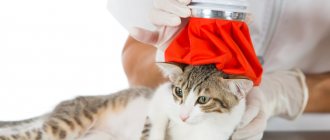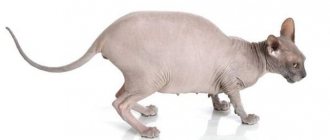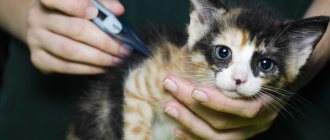Low or high body temperature in sphinxes can signal serious health problems that need to be eliminated as soon as possible with medications. If the temperature does not stabilize over the course of several days, and the cat experiences fever, fever, nausea and other unpleasant symptoms, then you should not delay contacting the veterinary clinic.
Hyperthermia in cats
The mechanism for increasing the temperature of the animal body is based on an imbalance between the process of heat generation (heat production) and heat transfer. The balance can be disturbed under the influence of unfavorable ecto and endofactors of various natures.
- overheating, heat stroke;
- the presence of pathogenic flora in the body that provokes viral-bacterial, parasitic diseases, systemic pathologies;
- development of inflammatory processes;
- poisoning, severe intoxication;
- disruption of the functioning of internal organs;
- exacerbation of chronic pathologies;
- an excess of salts in the body, which leads to increased breakdown of proteins and metabolic disorders.
In small kittens, an increase in temperature by one or two degrees above normal can signal the presence of endoparasites and the development of helminthic infestation.
Important! Elevated temperature in infectious and viral diseases is a physiological protective-adaptive reaction. If a cat suffers from diseases of non-infectious etiology, temperature readings may also be elevated.
- lethargy, apathy, drowsiness;
- rapid breathing, shortness of breath;
- disruption of digestive processes;
- increased thirst;
- rapid pulse, palpitations, high blood pressure;
- convulsions, muscle spasms, fever.
The cat refuses food and favorite treats and is in a depressed state. Possible severe vomiting and diarrhea.
This is interesting: How do Sphynx cats mate?
Causes of low temperature
The main reason for a cat's temperature drop is hypothermia. It is more dangerous when the animal was walking on a cold, damp street: the fur gets wet, the warming air layer disappears, and the cat begins to freeze.
If a kitten or an elderly cat finds itself in unfavorable conditions, then it is more difficult for them to maintain normal temperature readings in cold weather. An older cat may have liver or kidney disease, which also results in hypothermia.
Other reasons include various pathologies of the body, exhaustion, starvation, massive blood loss, internal bleeding, heart and vascular diseases, cancer, viruses, and nervous diseases.
We recommend reading: What to do in case of false pregnancy in dogs
What is the body temperature of Sphynx cats?
Hello friends. What do you know about the Canadian Sphynx? These are extraordinary cats without hair, similar to fairy tales...
Sphynx cats are perhaps the most unusual representatives of the domestic cat kingdom. They seem to be some kind of alien creatures. There are many misconceptions about them that need to be addressed.
In mythology, the sphinx is a monster with the body of a lion and the face and breasts of a woman. The most famous statue is the Great Sphinx.
We suggest you read: Which cats are better at catching rats and mice
According to the definition of Titus Flavius, a Roman scientist and writer, the Egyptian sphinx is a symbol of strength and intelligence: the lion's body denotes strength, the human face - intelligence. The sphinx needs both strength and intelligence to guard pyramids and temples full of treasures.
Contrary to the associative opinion that cats - sphinxes - came from Egypt, the first mention of them appeared among the Aztecs. They were called Mexican hairless cats.
An interesting fact: for most of the year they were indeed bald, but with the onset of cold weather they grew overgrown with fur, which they then “shed” during the warming period.
There were also references to hairless cats - participants in cat shows of the 20s, but the last pair of animals, unfortunately, did not leave offspring. In the 1930s, hairless cats were reported from France, Morocco and the United States. French biologist professor E.
Lethar documented hairless kittens born from a pair of Siamese cats and described a mutation caused by the h gene.
The first modern hairless kitten was born to a Canadian cat in 1966. The breeders became interested in the original cat and did everything possible to continue the breed. And in the late 80s, the first hairless cat was born in Rostov-on-Don, becoming the founder of the Don Sphynx family.
At the same time, St. Petersburg felinologists developed the Peterbald breed, independently of their Rostov colleagues. All three varieties have not only external, but also emotional differences.
The Canadian Sphynxes are considered the calmest and friendliest, distinguished by their rounded ears and smooth lines.
The Don Sphynx has a more elongated and sharply defined muzzle, while Peterbalds are distinguished by the greatest sophistication, huge ears and elongated proportions.
In addition, each breed has acceptable coat options - from completely bald “rubber” cats without mustaches and eyebrows to those covered completely or partially with hair of different lengths. It's funny that at first they tried to treat the first-born Sphynx cubs for lichen, until they realized that the lack of hair was a normal feature of their body.
The body temperature of adult Sphynx cats can reach 39 degrees. They love to sleep under a blanket next to their owner - they warm themselves.
This same feature is responsible for the rapid progression of colds and excellent appetite - the Sphynx's metabolism is much faster than that of cats of other breeds.
If the room in which the sphinx lives is too well heated, and the temperature in it exceeds 20-25 degrees, brown, waxy sweat appears on the animal’s body. However, the latter can be easily wiped off with a damp cloth.
The skin of sphinxes is quite dense, which simplifies the injection procedure during treatment. It will be quite easy to give an injection to a “naked” animal.
Due to the specific characteristics of the skin, short-term sunbathing is recommended for sphinxes, but in no case leave your pet for a long time under the scorching midday rays - the skin of these cats burns faster than that of a person. Most Sphynx cats love to bathe, but you should choose detergents from the gentle children's category.
We invite you to read: Colors of Maine Coon cats – Zhivomag
Despite their frightening appearance for most, sphinxes are distinguished by their friendly nature and high degree of socialization. This is an animal that is directly contraindicated from being alone for a long time. Many breeders notice “canine” character traits in their pets - incredible loyalty, sociability and trainability.
The Sphinx is one of the few cats that will respond and come running when they hear their name, not because you are holding a piece of sausage in your hands, but simply because you called.
In addition, these cats are similar to humans - they have natural toes on their paws, and sphinxes prefer to sleep under a blanket, with their heads on a pillow.
The Sphinx puts itself on the same level as its owner, preferring equal relationships rather than the royal behavior inherent in cats.
Thanks to their enviable metabolism, Sphynx cats have an excellent appetite and a complete lack of pickiness. But there are also pitfalls here - unlike the usual breeds of cats, the Sphynx rarely leaves the bowl half empty, so you need to feed it in portions and very carefully to prevent overeating.
Particular attention should be paid to the animal's ears - increased secretion provokes plaque accumulation faster than in an ordinary cat.
Some veterinarians, not knowing the specifics of the breed, begin to treat a cat for ear mites, so be careful and warn the doctor about the characteristics of your pet that you know.
Otherwise, the Sphynx is much easier to care for and maintain than long-haired cats. It does not leave wool on clothes and is highly clean.
Elongated proportions, curved front legs and lack of hair create the impression of a gentle and defenseless creature, including against viruses and infections. Add to this the stereotype about the good health of outbred cats and the weakness of purebred cats, and you get the myth that with a Sphynx you will not leave the veterinarian's office.
In fact, the immunity of the sphinx is in no way inferior to the immunity of the yard Vaska, and even vice versa. Elevated body temperature helps to quickly cope with viruses and infections. Even if the Sphynx has a cold, he will recover fairly quickly.
Don’t be afraid to give your pet physical activity - playing with a fishing rod, balls and in cat complexes will strengthen the body and help maintain the health of the Sphynx.
Many allergy sufferers who dream of having a pet at home opt for Sphynx cats, arguing that they have no fur.
In fact, the main cause of cat allergies is not fur, but an allergenic protein found in saliva, sebaceous gland secretions and particles of the animal's epidermis.
Symptoms may be reduced because the Sphynx grooms herself less often and does not leave allergens along with her fur throughout the apartment, but this does not mean that the reaction will be completely absent.
If you decide to get a hairless pet and are convinced that the reaction to it is not as intense as to fluffy cats, remember a few simple rules. First, intact males produce more allergen than castrated males.
We invite you to familiarize yourself with: Domestic cat breeds bred from wild counterparts
Secondly, dark cats produce significantly more allergens than light cats. And thirdly, cats produce more allergens than cats.
In fact, no breed of cat is confirmed to be hypoallergenic, so you need to select a pet individually.
This article will talk about what the body temperature of sphinxes should be. And also what should be done if your pet has an elevated temperature or hypothermia.
Should a Sphynx be bathed?
The skin of an ordinary cat is hidden under fur and undercoat. This protects the animal from injury and helps with thermoregulation. The sphinx does not have such powerful guards. His body is covered with short, delicate, almost invisible fur. The velvety and pleasant skin of the Sphinx is similar to suede or velor to the touch.
This exquisite “clothing” does not protect its owner from temperature changes. Therefore, nature took care of the Sphinx. The body temperature of a hairless cat is approximately 39-40.5 ° C, which is 0.5-1 degrees higher than that of an ordinary cat. Accordingly, the sweat and sebaceous glands of the Sphynx work in a more active mode than in other breeds.
The results of the activity of these glands remain on the skin even after thorough daily cat washing. Sweat and fat accumulate in the folds, creating a favorable environment for the development of harmful bacteria. To this are added house dust, carpet lint, and particles of toilet filler.
Natural lubrication turns brown after 2-3 weeks, and the Sphynx's skin becomes unpleasantly greasy. The animal begins to leave marks on the fabric upholstery of the furniture. Added to these unpleasant circumstances is a nasty smell.
This is why Sphynx cats are recommended for more frequent bathing procedures than other cat breeds. Bald pets can and should be bathed regularly, without waiting for the smell to appear.
Important! If the cat quickly becomes covered with a brown coating and you have to wash the Sphynx too often, you should pay attention to its diet. Perhaps the diet was chosen incorrectly. This issue should be discussed with your veterinarian.
Symptoms and causes of hypothermia
An obvious decrease in temperature is diagnosed when the indicator drops below 37 degrees; the most critical position of the thermometer will be at around 28. Additional symptoms will indicate the development of pathology:
- rare, difficult breathing;
- pallor of the skin and mucous membranes;
- apathetic, indifferent state;
- sensation of trembling in the muscles when touching the animal’s body;
- dilated pupils;
- weakened sensitivity.
If these signs are present, a visit to the veterinary clinic is required to clarify the diagnosis and take urgent measures to normalize thermoregulation. External signs may indicate the development of a pathological process.
How to increase the temperature of a sphinx
Before visiting your veterinarian, treat your hairless pet at home using the following methods:
- Choose any warm place where there are no drafts.
- Carefully lay the cat down, wrapping him in a warm blanket or blanket.
- If the temperature drop is severe, apply a heating pad with warm water to your back.
- Try to give the cat heated water to drink; if he cannot drink on his own, use a syringe.
Thermoregulation of the Sphynx
The issue of thermoregulation for sphinxes is quite acute. Maintaining a constant body temperature for sphinxes is a vital issue. If overcooled, sphinxes can die from pneumonia, and if overheated, from heatstroke.
Newborn Sphynx kittens are not able to maintain their body temperature on their own . Without maternal warmth, even at a temperature of + 18 °C, they can die from hypothermia. Kittens warm themselves from their mother cat. And when it’s hot they creep apart from each other. It is during the suckling period that Sphynx kittens learn to seek warmth and maintain a constant body temperature using an external heat source.
The normal body temperature of a Sphynx kitten is on average from 38.5 to 39.5 °C. In a growing body, metabolic processes occur faster, and therefore the body temperature is higher. In adult cats, this figure ranges between 38.0 and 39.0 °C. If the external environment somehow affects the cat’s body, be it cold or heat, the animal will take measures to normalize its body temperature.
If the Sphynx is cold , it will look for a source of warmth, like a newborn kitten. Sphinxes can bask in the sun, on a radiator, or on any device that produces heat. For heating, they use a dog or any other animal as a living heating pad without any complexes. But the most pleasant thing for a sphinx is to stay warm, clinging to its beloved owner.
It must be remembered that in hairless cats, things are much more complicated with thermoregulation. The Sphinx must be protected from drafts in cool weather. And in hot weather, make sure that the Sphynx does not overheat, because the lack of fur contributes to faster overheating.
HOW TO HELP THE SPHINX SURVIVE THE HEAT
In summer , sphinxes feel quite comfortable . However, the room must be ventilated: during periods of abnormal heat, do not forget to leave the windows open.
When the Sphynx is hot , he sleeps all the time, at times moving from shade to sun and vice versa - this is how cats regulate their body temperature. Therefore, there is no need to drive your pet away from the sunny windowsill, trying to put it in the shade. But make sure that the Sphynx does not doze for too long under the scorching rays of the sun, so he can get heatstroke in his sleep, and he will not have the strength to move to the cooler area of the house.
If the sphinx does not have the opportunity to get away from the heat , then its breathing quickens. The cat may begin to breathe rapidly—up to 250 breaths per minute—while keeping its mouth open and its tongue slightly protruding, like a dog. But this method of cooling through breathing causes loss of fluid from the body, which further leads to dehydration.
Drinking water when the external temperature rises not only helps the sphinx cool down , but also prevents the development of dehydration due to rapid breathing. Therefore, it is very important in hot weather to remember to change the water as often as possible and always make sure that the bowl is full.
Some sphinxes like to take baths in the summer , washing themselves with cool water flowing from the tap. If your Sphynx is a fan of such water procedures, do not forget to turn on the water in a thin stream several times a day, but you should not force the cat to bathe.
Make sure that the sphinx does not fall asleep under the air flow from a fan or air conditioner .
HEAT STROKE: SYMPTOMS AND FIRST AID
- the sphinx often breathes like a dog, with its mouth open - this is a very alarming sign; such breathing is unusual for cats;
- the sphinx lies stretched out, spread out, does not respond to the sounds and voice of the owner, to touch; if the sphinx does not lie down, but tries to go somewhere, but its movements are constrained, this indicates that it is disoriented;
- the sphinx breathes frequently, but shallowly;
- pulse is threadlike;
- the pupils are dilated, do not respond to light, the mucous membranes are scarlet or, conversely, pale;
- The Sphinx's body temperature is above 39 degrees.
We recommend reading: Growth on a Dog's Lip
If, despite all precautions, the sphinx still receives heatstroke , you need to immediately help him cool down. This is not difficult to do - wrap the sphinx in a cool wet towel and take it to a cool room, give it a drink of cool water, and lightly wipe the pet’s face and body with it. Remember that overheating can lead to swelling of the lungs and brain, so the Sphynx needs to be taken to a veterinary clinic immediately , even if he has woken up and you think he is feeling better.
HOW TO HELP THE SPHINX SURVIVE THE HEAT
Symptoms of fever in a cat
The cat's body temperature can be lowered or increased. If the owner is attentive to the pet, he will not miss the alarming symptoms.
External signs of hyperthermia in cats:
- lethargic state;
- rapid pulse;
- strong thirst;
- nose feels dry and hot to the touch.
To find out what indicators are normal for a cat, you need to measure the indicators for several days in a row in a healthy state. Then the new value on the thermometer will reveal a deviation from the norm.
Signs of hypothermia:
- shivering from freezing;
- apathetic and lethargic state;
- pallor of visible mucous membranes;
- the cat is looking for a warmer place;
- cool stomach;
- decreased appetite;
- breathing becomes less frequent.
In any case, it is important to establish the reasons for changes in habitual indicators.
First aid for a pet
If your pet’s temperature has risen to 39.5-41 degrees, it is urgent to take appropriate measures aimed at normalizing the furry pet’s condition.
Contact your veterinarian for help. Only a qualified specialist can establish the root cause of hyperthermia, determine why the temperature is elevated and why the cat feels unwell, after conducting a comprehensive diagnosis.
If the temperature is very high, the cat feels unwell, before the veterinarian arrives or visits the veterinary clinic, to alleviate the condition of the fluffy, lightly moisten the fur with cool water. Apply a cold compress to the inner thigh, ice cubes on the neck, scruff. The cat should be placed in a cool place. Provide plenty of fluids. If the cat refuses to drink water, pour small portions into the animal's mouth with a syringe without a needle.
In case of hypothermia, if the temperature is low, cover your pet with hot water bottles and wrap the animal in a warm woolen blanket. The cat should be kept warm, away from drafts and heating appliances. Ensure maximum peace. You can give warm sweet tea, chamomile decoction.
If the condition does not return to normal, the temperature is low, take your pet to the veterinary clinic. Animals are given oxygen therapy and given intravenous infusions of warm solutions. Constant monitoring of temperature indicators is carried out until the general condition stabilizes.
After treatment, follow all recommendations of the treating veterinarian. Provide proper care. Do not self-medicate if you do not want to aggravate the situation or provoke serious complications. Therapeutic therapy and treatment regimen should be prescribed by a veterinarian.
What can you give your cat for fever at home?
You should give medications to your pet only after the doctor’s recommendations.
As for treating a cat, it all depends on the cause of this pathology, as well as the severity of the situation. In some cases, there is no need to panic, since the animal’s body is able to independently fight some viruses and infections.
Treatment with antibiotics
If the diagnosis is not entirely clear, the doctor prescribes a course of treatment using antibiotics. Antipyretics are often prescribed, but it all depends on the cause. Before giving any medications to your cat, consult your veterinarian to avoid serious complications.
Folk remedies
What to do at home? It is advisable to use cool water to dampen the cat's fur. If you have ice, you can safely apply it to the cat's neck and also to the inner thighs. As for more radical treatment, it is better to consult a doctor. Provide the animal with enough water to drink. If the situation is urgent and the cat gets worse, you can do a little trick. You will need vodka, diluted vinegar or alcohol to lubricate the paw pads every hour.
Symptoms and causes of fever
An increase in the Sphinx's normal temperature above 39 degrees occurs due to overheating or the development of an inflammatory process. A particular danger is the possibility of cerebral or pulmonary edema. Classic signs of heat stroke will be:
- Rapid mouth breathing, shortness of breath when the pet is at rest.
- Shallow breaths, with the tongue often sticking out of the mouth.
- Unfocused gaze and inadequate state, poor orientation in space.
- The presence of a weak pulse, the inability to count contractions of the heart muscle.
- Change in the color of the mucous membranes, uncharacteristic rich or too pale color.
Important! An increase in temperature leads to a lack of reaction to the owner's calls, the pet is in a lying position, and it is difficult for him to move due to weakness.
How to reduce fever: antibiotics and folk remedies
At the first sign of a fever in your pet, you should do the following:
- Wrap the Sphynx's body with a damp towel.
- Place the animal in a cool place in the room so that it is not exposed to direct sunlight, but not too cold so as not to cause reverse hypothermia.
- Wipe the animal's face and ears with a cotton pad soaked in water.
- Give cool water if the cat does not refuse to drink, otherwise let him lick an ice cube.
An increase in temperature requires an urgent visit to the veterinary clinic to accurately determine the cause of the thermoregulation disorder. You can reduce your temperature with medications at home only after examination by a doctor.
Important! Condition stabilization is most important for kittens that are poorly adapted to changing environmental conditions.
Signs of a hairless pet's normal temperature rising and falling will be a dangerous indicator. If there are temperature fluctuations that do not go away within two days, a visit to the veterinary clinic will be mandatory, and the doctor’s recommendations will help prevent the development of serious diseases.
How to bring down the temperature?
At home, a wet towel in which the cat is wrapped will help reduce the indicators.
If your pet has a very high body temperature and pathological symptoms are observed, it is recommended that you contact a veterinarian as soon as possible. The clinic will conduct a diagnosis, find out the reasons for the increase in temperature and select a treatment that will help bring down the readings on the thermometer and eliminate the underlying disease. At home, it is possible to alleviate the condition of a pet by performing the following actions:
- Wrap your pet in a wet towel or blanket to reduce symptoms of heat stroke.
- Carefully wipe the sphinx's face and ears using cotton pads.
- Place the animal in a cool place, but not too cold, so that sudden hypothermia does not occur.
- They try to give him cold liquid to drink. You can use an ice cube that your cat can lick.
Even if using home methods it was possible to bring the cat’s temperature back to normal, you should contact a veterinary clinic, since such a case is the first sign of serious illness in the animal. With advanced overheating, this type of cat has a high risk of swelling of the brain and lungs. Elevated temperature is especially dangerous for kittens, which may die if their condition is not stabilized in a timely manner.
Signs of hypothermia
A low temperature in a Sphynx can be fatal if the owner does not notice the problem in time and does not contact a veterinarian. When hypothermia occurs, the temperature drops to 37 and below; the critical mark on the thermometer is 28. Pathology can be recognized by additional symptoms:
- weak palpation of the pulse;
- rare breathing;
- pale mucous membranes and skin;
- trembling in the muscles of the Sphinx;
- poor sensitivity;
- lethargic and apathetic state;
- wide pupils.
What to do if you are hypothermic
If your pet has developed hypothermia, then you need to see the signs and symptoms in time, as well as have an idea of how you can help your pet as soon as possible.
Signs and symptoms of hypothermia:
- Depending on the degree of hypothermia, the pet’s body temperature can vary from 28 to 37 degrees;
- Weak pulse and rare breathing;
- Excessive pallor of the mucous membranes;
- Trembling in the animal's muscles;
- Weakening of sensitivity, lethargy, apathy;
- Pupil dilation.
shutterstock
First aid for hypothermia:
- First of all, wrap the cat as warmly as possible (for example, in a blanket);
- Place in a chair or any other warm place;
- If hypothermia is severe enough, then you should apply a heating pad on the side of the pet’s back;
- In this case, it is useful to give the animal a warm liquid to drink.
If the temperature drops sharply and there is no positive dynamics from the measures taken, you must immediately contact a veterinarian!
Treatment of fever in a cat
Neither hypothermia nor hyperthermia should be ignored. As stated above, there are serious reasons for a decrease or increase in temperature that must be found and eliminated. It is better to consult a veterinarian: you may need to conduct an examination and undergo tests.
How to increase the temperature
A frozen and shivering cat is brought into a warm room. The wet fur is dried with a hairdryer.
A kitten with hypothermia urgently needs to be warmed in any way: a blanket and heating pads will do. You can simply hold your baby close and wrap yourself up with him. An adult cat also needs warmth. Be sure to offer warm drink and food after the animal stops shaking.
If the low temperature lasts for a long time or the indicators have dropped significantly, the animal should be taken to a veterinary clinic rather than trying to treat the cat at home.
How to reduce a cat's fever
With a slight increase in body temperature, cats do not fuss and do not knock it down. But a significant increase signals that it’s time to intervene. High values on the thermometer threaten the cat's body with dehydration, which is fraught with the worst consequences.
There are several tips to help lower your cat's temperature :
- the wool is slightly moistened;
- Ice is applied to the neck and inner thighs;
- Give the cat a cool drink.
If there is no decrease, the animal is shown to a specialist.
How to take a cat's temperature
Not all owners know how to correctly measure a cat's body temperature . It's actually easy to do. For this you need a thermometer, and it is better if it is an item only for the use of the animal. Purchase a thermometer at a pharmacy.
Temperatures are measured with a mercury thermometer, an electronic universal thermometer, or an electronic rectal thermometer. Electronic products provide results faster and are more convenient to use.
Since the temperature of animals is measured in the rectum, it should be understood that you will have to act against the cat’s wishes. Often, the procedure requires the help of members of the household. The cat is secured with a towel or any fabric - you need to hide the paws by wrapping the pet in a “cocoon”. You can simply hold the cat by the paws with one person, holding the head by the scruff of the neck, while another person takes the measurement.
Before inserting the thermometer into the rectum, its tip should be lubricated with Vaseline. If the thermometer is mercury, hold it for no more than 5 minutes.
After the procedure, the thermometer is disinfected with any means.
How to help your pet and raise the temperature?
You can stabilize body temperature after hypothermia by covering your pet with a warm blanket.
If the owners find symptoms of hypothermia and a low temperature in the Sphinx, then they need to know how to help their pet at home. First you need to wrap your pet in a warm blanket, blanket or towel to warm him up and stabilize his temperature. Place the sphinx in a chair or other warm corner. In case of severe hypothermia of the cat's body, apply a heating pad to the cold back of the animal. If possible, it is recommended to give the cat warm water to drink. When he refuses to drink the liquid on his own, you can try to inject it into the animal using a syringe. It is worth monitoring the condition of the sphinx and if there is a significant decrease in temperature and pathological signs, it is necessary to immediately take the pet to a veterinary clinic.
What is normal temperature?
The Canadian and Don Sphynx have the same body temperature as other breeds of the cat family. Many owners believe that a cat’s normal temperature should be 42 degrees, but this opinion is erroneous. Such speculation arose due to the fact that when you touch the skin of the sphinx, it is very hot. The normal temperature for this breed is 38-39 degrees, and anything lower or higher than normal is pathological.
Veterinarians note that the temperature of Sphynx kittens may be slightly higher than that of adults by 0.5 degrees. This is explained by the active processes of growth and development in a young body.
Owners should regularly monitor their thermoregulation, as this is a problem area for Sphynx cats due to their lack of fur. It is especially important to monitor the body temperature of young cats, since kittens are not able to carry out normal thermoregulation and even if it is 18 degrees in the house or outside, they can become hypothermic and get sick. If the case is advanced and veterinary care is not provided on time, the sphinx may die.
In winter, animals look for cozy, warm places, and in the hot season, on the contrary, cool ones.
Adults are able to regulate the heat exchange of their own body, and in winter they hide in warm places, and in summer they try to find coolness. All Sphynx owners should know that it is not recommended to expose them to drafts, as there is a high risk of hypothermia. Against the background of a significant decrease in temperature, the cat develops rhinitis, laryngitis, and pneumonia.










